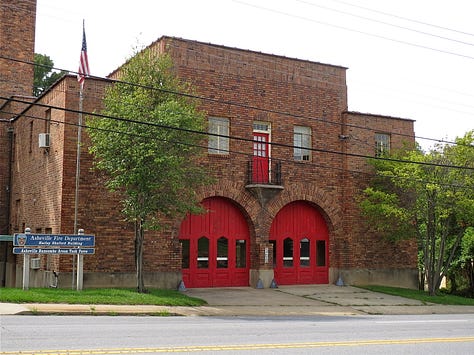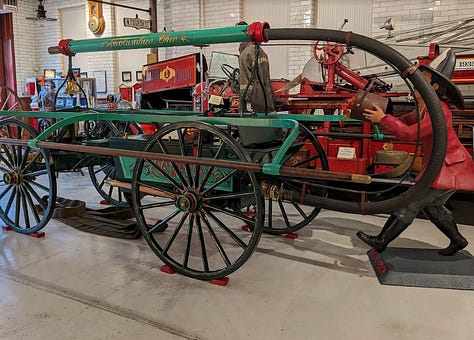As savvy museum visitors, interested in art, culture, and history, we see the “front of the house” when we visit museums. Here’s a chance to peek behind-the-scenes at a museum in Ohio. The Central Ohio Fire Museum provides insights and education on a niche topic. Museums that cover local history and niche topics are critical cultural centers in sharing about topics that are often neglected by larger regional or national museums. Samantha Kerr shares about her museum and her role at the museum.
Describe your museum for us
I work at the Central Ohio Fire Museum and Learning Center, located in downtown Columbus Ohio. The building we’re in is a 1908 restored Columbus Engine House and is on the National Register of Historic Places.
NOTE: To be eligible to be listed on the National Register of Historic Places, sites are typically at least 50 years old. Also, they are historically significant in regards to a person, an event, or their design. And, they retain their historic integrity such as materials or setting. The National Park Service administers the National Register program, and it is overseen at the state level by State Historic Preservation Offices (SHPOs).



We have four paid staff and about 10 volunteers that give tours covering three generations of fire trucks (hand-drawn, horse-drawn, and motorized). We also have numerous pieces of fire history that were donated to us from retired firefighters or families of past firefighters. In addition to our fire trucks, our exhibits include a Safety Kitchen, a Safe Bedroom, information about life in the firehouse, and more.



What is your job title and what are your main responsibilities?
I am a Certified LIfe and Fire Safety Educator. We are lucky enough to have an amazing fire prevention program that we teach all year round. I teach all ages from preschoolers to senior citizens. This includes homeschool groups, summer camps, and adults with disabilities. I also give tours to walk-in visitors. In addition, I’m working in a new capacity that we've never really had, and that's social media and public engagement. We’re in the early phases of this so we’ll see where it goes!
NOTE: Fire prevention not only saves lives, but it also protects property, minimizes the devastating impact of fires on communities, and reduces negative environmental impact. Fire is the leading cause of death and injury among children and seniors.
What education and experience did you have before you took this job?
I had no museum or customer service experience before this job but I am an active firefighter. I’ve been a firefighter 14 years with Junction City Fire Department. To broaden my knowledge, I was able to get some different qualifications. I worked in corrections and was able to go through the state’s 40-hour state instructor course. I was also able to work with the state fire marshal's office and get certified as a life and fire safety educator.
What’s your one most favorite thing about your job, and what’s your least favorite thing?
I think my favorite thing about working at the museum is being able to teach people important information about fire safety they may not know. Also, getting down on the kids’ level and making learning and the tours fun is something that I hope they think about for a long time. My least favorite thing is not being able to do more work with the community outside of fire prevention. There are so many things we would love to do and great ideas but being such a small network, it can be frustrating sometimes.
How does your museum put a focus on the visitor experience and wellness?
I think that we do a great job with the visitor experience. We offer personalized tours that allows us to give tours to everyone no matter how young or old. We have a play area for kiddos to add to their experience, so you can bring your whole family. The play area includes opportunities to “drive” a fire truck, slide down a pole, put out a “fire” using a real hose, and dress up in firefighter clothes.



We also work hard to be handicap accessible. There are no steps to get into the building, the doorways are wide enough for wheelchairs, and we have baby changing stations not just in our women's restrooms but the men's restrooms as well! We also use Google Translate to support our visitors as we get visitors from all over the world!
What’s an example of how your museum makes an impact?
I believe that we make difference every single day as we teach fire prevention. It allows us to guide adults and children alike to think about how you can help yourself in the event of a fire. And, we’re proud that even seasoned firefighters talk about how amazing our fire prevention interactive displays are!
What do you wish museum visitors understood about museums that they probably don’t?
I wish that they knew what a good resource museums can be and how they can really help the community. Most museums aren't these stuffy and dark places that people never go to! They are bright and lively. It can be so fun!
Thank you to Samantha and Central Ohio Fire Museum and Learning Center!
[NRHP IMAGES: By Karen D. Hoffman - Own work, CC BY-SA 3.0, https://commons.wikimedia.org/w/index.php. CC BY-SA 3.0, https://commons.wikimedia.org/w/index.php. By Magicpiano - Own work, CC BY-SA 4.0, https://commons.wikimedia.org/w/index.php]
Chat topics: Art Deco jewelry. One of the greatest silversmiths. Quilts.






I live just outside Columbus and this makes me want to visit this museum this summer. I’ve driven by several times but have never thought about visiting it.
Thank you, Samantha! You made me smile!!